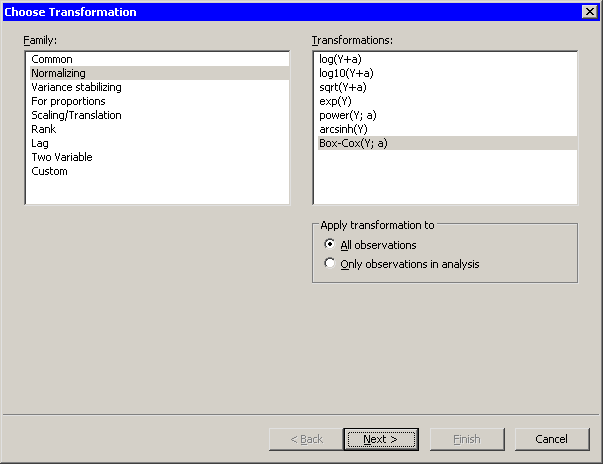Variable Transformations
Normalizing Transformations
Figure 32.12 shows the transformations that are available when you select from the list. These transformations are often used to improve the normality of a variable. Equations for these transformations are given in Table 32.2.
Figure 32.12: Normalizing Transformations

Table 32.2: Description of Normalizing Transformations
|
Default |
Name of |
||
|---|---|---|---|
|
Transformation |
Parameter |
New Variable |
Equation |
|
log(Y+a) |
|
Log_Y |
|
|
log10(Y+a) |
|
Log10_Y |
|
|
sqrt(Y+a) |
|
Sqrt_Y |
|
|
exp(Y) |
Exp_Y |
|
|
|
power(Y;a) |
|
Pow_Y |
|
|
arcsinh(Y) |
Arcsinh_Y |
|
|
|
Box-Cox(Y;a) |
MLE |
BC_Y |
See text. |
The Box-Cox transformation (Box and Cox 1964) is a one-parameter family of power transformations that includes the logarithmic transformation as a limiting case. For
 ,
,
![\[ \mbox{BC}(y;\lambda ) = \left\{ \begin{array}{l l} \frac{y^\lambda - 1}{\lambda } & \mbox{if } \lambda \neq 0 \\ \log y & \mbox{if } \lambda = 0 \end{array} \right. \]](images/imlsug_ugvartransform0018.png)
You can specify the parameter,  , for the Box-Cox transformation, but typically you choose a value for
, for the Box-Cox transformation, but typically you choose a value for  that maximizes (or nearly maximizes) a log-likelihood function.
that maximizes (or nearly maximizes) a log-likelihood function.
SAS/IML Studio plots the log-likelihood function versus the parameter, as shown in Figure 32.8. An inset gives the lower and upper 95% confidence limits for the maximum log-likelihood estimate, the MLE estimate, and
a convenient estimate. A convenient estimate is a fraction with a small denominator (such as an integer, a half integer, or an integer multiple
of  or
or  ) that is within the 95% confidence limits about the MLE. Although the value of the parameter is not bounded, SAS/IML Studio
graphs the log-likelihood function restricted to the interval
) that is within the 95% confidence limits about the MLE. Although the value of the parameter is not bounded, SAS/IML Studio
graphs the log-likelihood function restricted to the interval ![$[-2,2]$](images/imlsug_ugvartransform0019.png) .
.
A dialog box (see Figure 32.9) also appears that prompts you to enter the parameter value to use for the Box-Cox transformation.
The log-likelihood function for the Box-Cox transformation is defined as follows. Write the normalized Box-Cox transformation,
 , as
, as
![\[ \bm {z}(\lambda ; y) = \left\{ \begin{array}{l l} \frac{y^\lambda - 1}{\lambda \dot{y}^{\lambda -1}} & \mbox{if } \lambda \neq 0 \\ \dot{y} \log y & \mbox{if } \lambda = 0 \end{array} \right. \]](images/imlsug_ugvartransform0021.png)
where  is the geometric mean of y. Let N be the number of nonmissing values, and define
is the geometric mean of y. Let N be the number of nonmissing values, and define
![\[ R(\lambda ;\bm {z}) = \bm {z}’\bm {z} - \left(\Sigma z_ i \right)^2 / N \]](images/imlsug_ugvartransform0023.png)
The log-likelihood function is (Atkinson 1985, p. 87)
![\[ L(\lambda ;\bm {z}) = -(N/2) \log (R(\lambda ;\bm {z})/(N-1)) \]](images/imlsug_ugvartransform0024.png)







